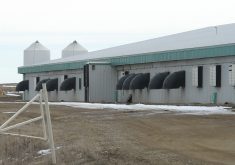Solar-heated air is an effective heat source, but only to a point. That’s because air does not hold much heat.
Most homes use heated air with their forced air heating systems, but the air must be moved immediately to be effective.
This means the effectiveness of solar-heated air depends on the application.
Installing a solar air collector on a home may be less valuable than installing a window in the same location. The light from the window can penetrate into the building, directly striking objects that will retain heat for later release.
Read Also

Phosphate prices to remain high
Phosphate prices are expected to remain elevated, according to Mosaic’s president.
Solar-heated air is more effective where significant air changeover is required, such as health-care facilities.
It is also efficient in commercial and industrial applications, where massive amounts of air are required to maintain good air quality and plant operating hours coincide with sunlight hours.
As well, one of the best applications is drying grain.
Grain is dried in two ways: circulating ambient air through the grain or artificially heating the air before it reaches the grain in more difficult situations.
An electric heater is sometimes used to preheat air going into the aeration fan when grain remains in the storage unit. When grain is removed from storage for drying, a batch or continuous flow dryer is used with propane or natural gas as the heating source.
When solar heaters are used, they serve as a pre-heater to an aeration fan. The most elemental solar heating units use a large air mattress through which the air passes and is heated by the sun.
Their ability to capture solar heat is limited because they lie on the ground. As well, grain is typically dried in fall and winter when the sun is at a much reduced angle and solar input is substantially lower than in summer. Mattresses can also be easily damaged because they are plastic.
Building-mounted or mobile units are more effective but also more costly. The mobile version could also serve to augment heat in a shop when not drying grain.
Solar capture is best done with aluminum because of its good heat transfer capability.
It is particularly effective when the coating has good absorption and low reflectivity characteristics, typically a deep brown matte finish.
The aluminum material is louvered so the air absorbs stored heat while passing from outside to inside.
The most effective all-season units have a form of glazing that protects the louvered material from heat loss to wind.
Well-constructed solar air heaters can raise air temperatures from inlet to outlet by as much as 20 C , which makes a dramatic difference in moisture-holding capacity.
The solar heated air can reduce drying time and energy consumption by as much as 75 percent compared to aeration with a bin-mounted fan using only ambient air.
Solar grain dryers can also be used in winter, when they would seem most unlikely to be effective.
There is less sunshine in winter, but the air is dry and has great moisture-absorbing capacity when heated.
Drying grain in winter can be effective if the grain can be cooled so that storage is secure. Sunlight bouncing off the snow in the foreground enhances the efficiency.
Solar grain drying is particularly useful for organic growers who cannot introduce fossil fuel gases to the grain.
A solar air unit has no moving parts other than the aeration fan, and is not subject to deterioration or maintenance. Systems made from aluminum and galvanized metal should last for decades.
The glazing, if a plastic or fibreglass, is the only component that might require renewal.
Solar grain drying systems must face south when the sun is the strongest, which is why a system that wraps around a bin is less effective than one that faces entirely south.
A mobile unit must also face south preferably with an insulated conduit connecting to the aeration fan.
Will Oddie is a renewable energy, sustainable building consultant with a lifetime interest in energy conservation. To contact Oddie, send e-mail to energyfield@producer.com.














